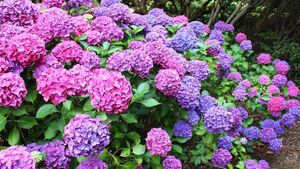Green Fingers: Mopheads and lacecaps are star performers

Pink, blue, lilac and purple flowers growing on a large hydrangea bush (Hydrangea macrophylla). Stock image
Before anyone starts overthinking what possible association mopheads might have to do with lacecaps, I might as well admit that they are also the common names for some of our prettiest summer flowering shrubs.
They and others are part of a large family collectively called hydrangeas that start to flower in the middle of July and continue well into the autumn, and their interest continues as the flowers turn an autumnal shade along with the fiery red, orange and gold tints of their leaves.
They are one of the most popular plants and do well in a wide range of soils and positions, including gardens by the coast.
For gardening purposes we can classify the hydrangeas into the mopheads and lacecaps as before but, include the larger growing paniculata types too as they are becoming more widely known.
The different classification in simple terms is that they are all divided into groups according to their flower shapes and mostly come in a similar range of colours like white, pink, red and blue.
Sometimes their popularity leads a few people to think they are too common to provide an interesting addition to their garden and they are dismissed for this reason, whereas, the truth is that the range is so huge that there will be some that will suit all tastes, which can come in flower form and colour and again in foliage as in the oak leaved types.
While hydrangeas will grow satisfactorily without any special treatment, they will really take off if an extra effort can be made to give them the best start in their final position and that includes the soil being free draining and full of composted manure.
An annual mulch of compost or bark will help maintain the rich soil and help maintain moisture levels during periods of drought.
Hydrangeas are also available in flower as pot plants in florist shops and other outlets that sell flowers but, they have been forced and are principally used as indoor and seasonal decoration.
Many people do seem to think they can be planted out after they have finished flowering but, the success rate for establishment is low as they were never intended to end up this way but, it is worth a try and if planted in the spring it can work.
The mopheads (M) are those with a dome-shaped head and are historically the most popular and closely followed by the lace caps (L) which have flattened heads surrounded by a ray of florets and finally paniculata (P) which have large dome-shaped panicles and from which a new range of colours and varieties have been recently introduced.
It is difficult to keep the list of good varieties short but they would include some of the following- the best reds are ‘Red Beauty’ (M), ‘Amsterdam’ (M) and ‘Hot Red’(M), while the blue shades are ‘Sky Blue’ (L), ‘Renate Steinger’ (M) and good whites are ‘Snow Queen’ (M) and ‘Limelight’ (P) a white which turns a beautiful shade of lime.






